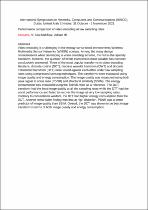JavaScript is disabled for your browser. Some features of this site may not work without it.
- ResearchSpace
- →
- Research Publications/Outputs
- →
- Conference Publications
- →
- View Item
| dc.contributor.author |
Skosana, Vusi J

|
|
| dc.contributor.author |
Abu-Mahfouz, Adnan MI

|
|
| dc.date.accessioned | 2022-01-24T07:52:01Z | |
| dc.date.available | 2022-01-24T07:52:01Z | |
| dc.date.issued | 2021-11 | |
| dc.identifier.citation | Skosana, V. & Abu-Mahfouz, A.M. 2021. Performance comparison of video encoding at low sampling rates. http://hdl.handle.net/10204/12237 . | en_ZA |
| dc.identifier.isbn | 978-1-6654-4829-1 | |
| dc.identifier.isbn | 978-1-6654-0304-7 | |
| dc.identifier.uri | DOI: 10.1109/ISNCC52172.2021.9615804 | |
| dc.identifier.uri | http://hdl.handle.net/10204/12237 | |
| dc.description.abstract | Video encoding is challenging in the energy-constrained environments Wireless Multimedia Sensor Networks (WMSN) operate. Among the many design considerations when developing a video encoding scheme, the first is the sparsity transform, however, the question of which transform is most suitable has not been conclusively answered. Three of the most popular transforms in video encoding literature, discrete cosine (DCT), discrete wavelet transform (DWT) and discrete Tchebichef transform (DTT) were tested against each other under low sampling rates using compressed sensing techniques. The transforms were evaluated using image quality and energy consumption. The image quality was measured using both peak signal to noise ratio (PSNR) and structural similarity (SSIM). The energy consumption was evaluated using the TelosB mote as a reference. The DCT transform had the best image quality at all the sampling rates while the DTT had the worst performance and failed to recover the image at very low sampling rates. Contrary to conventional wisdom, the DTT had higher energy consumption than the DCT. Another remarkable finding was that at high distortion, PSNR was a better predictor of image quality than SSIM. Overall, the DCT was shown to be best image transform in terms of both image quality and energy consumption. | en_US |
| dc.format | Abstract | en_US |
| dc.language.iso | en | en_US |
| dc.relation.uri | https://ieeexplore.ieee.org/document/9615804 | en_US |
| dc.source | International Symposium on Networks, Computers and Communications (ISNCC), Dubai, United Arab Emirates, 31 October - 2 November 2021 | en_US |
| dc.subject | Compressive sensing | en_US |
| dc.subject | Image compression | en_US |
| dc.subject | Video encoding | en_US |
| dc.subject | Wireless Multimedia Sensor Networks | en_US |
| dc.subject | WMSN | en_US |
| dc.title | Performance comparison of video encoding at low sampling rates | en_US |
| dc.type | Conference Presentation | en_US |
| dc.description.pages | 7 | en_US |
| dc.description.note | ©2021 IEEE. Due to copyright restrictions, the attached PDF file only contains the abstract of the full text item. For access to the full text item, please consult the publisher's website. | en_US |
| dc.description.cluster | Next Generation Enterprises & Institutions | en_US |
| dc.description.impactarea | EDTRC Management | en_US |
| dc.identifier.apacitation | Skosana, V., & Abu-Mahfouz, A. M. (2021). Performance comparison of video encoding at low sampling rates. http://hdl.handle.net/10204/12237 | en_ZA |
| dc.identifier.chicagocitation | Skosana, V, and Adnan MI Abu-Mahfouz. "Performance comparison of video encoding at low sampling rates." <i>International Symposium on Networks, Computers and Communications (ISNCC), Dubai, United Arab Emirates, 31 October - 2 November 2021</i> (2021): http://hdl.handle.net/10204/12237 | en_ZA |
| dc.identifier.vancouvercitation | Skosana V, Abu-Mahfouz AM, Performance comparison of video encoding at low sampling rates; 2021. http://hdl.handle.net/10204/12237 . | en_ZA |
| dc.identifier.ris | TY - Conference Presentation AU - Skosana, V AU - Abu-Mahfouz, Adnan MI AB - Video encoding is challenging in the energy-constrained environments Wireless Multimedia Sensor Networks (WMSN) operate. Among the many design considerations when developing a video encoding scheme, the first is the sparsity transform, however, the question of which transform is most suitable has not been conclusively answered. Three of the most popular transforms in video encoding literature, discrete cosine (DCT), discrete wavelet transform (DWT) and discrete Tchebichef transform (DTT) were tested against each other under low sampling rates using compressed sensing techniques. The transforms were evaluated using image quality and energy consumption. The image quality was measured using both peak signal to noise ratio (PSNR) and structural similarity (SSIM). The energy consumption was evaluated using the TelosB mote as a reference. The DCT transform had the best image quality at all the sampling rates while the DTT had the worst performance and failed to recover the image at very low sampling rates. Contrary to conventional wisdom, the DTT had higher energy consumption than the DCT. Another remarkable finding was that at high distortion, PSNR was a better predictor of image quality than SSIM. Overall, the DCT was shown to be best image transform in terms of both image quality and energy consumption. DA - 2021-11 DB - ResearchSpace DP - CSIR J1 - International Symposium on Networks, Computers and Communications (ISNCC), Dubai, United Arab Emirates, 31 October - 2 November 2021 KW - Compressive sensing KW - Image compression KW - Video encoding KW - Wireless Multimedia Sensor Networks KW - WMSN LK - https://researchspace.csir.co.za PY - 2021 SM - 978-1-6654-4829-1 SM - 978-1-6654-0304-7 T1 - Performance comparison of video encoding at low sampling rates TI - Performance comparison of video encoding at low sampling rates UR - http://hdl.handle.net/10204/12237 ER - | en_ZA |
| dc.identifier.worklist | 25218 | en_US |







